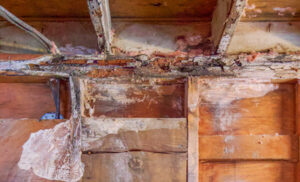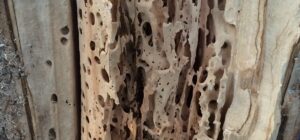Property owners must take action when signs of any kind of damage begin to appear in their home. Unfortunately, wood damage causes puts the the integrity of the structure that keeps you and your family safe in question. It is imperative that homeowners are able to recognize and eliminate any factor that may be causing destruction to their home.
Two common culprits of wood destruction are termite damage and/or wood rot. When you begin looking for the difference between termite damage or wood rot, it can be difficult, making your next steps even more challenging when searching for a solution.
What You Need to Know About Termites and Wood Rot
So, How Can I Tell The Difference Between Wood Rot & Termite Damage?
Let’s start by explaining the two. Termite damage is caused by the little pests that live in the soil surrounding your house. They feed on the cellulose that makes up wood, so when they find a way to access the wood in your home, either through a crack in your foundation or a crevice in a wall, they begin eating away at the inside of the wood. Wood rot, commonly confused as termite damage, is caused by the perfect formula of oxygen, moisture, and warmth, leading to the presence of fungi. This fungus performs the same action as the termites, eating away at the makeup of your home.
The task of determining whether you have wood rot or termite damage can be a difficult feat without the eye of an expert, but there are a few tips and tricks that anyone can use to establish the cause of wood damage.
How do you know if it is termite damage or wood rot? Termites eat wood from the inside out, when looking at it, you will see a wavy effect. Pieces of wood will be hollowed out and have some speckling, looking almost like a cork. Opposite to that is wood rot, which can either be wet or dry. Wet rot will cause the wood to be visibly darker and will feel spongy. You may even see pieces of the wood fall off. When inspecting dry rot, the wood will break and collapse if touched. If you are not able to tell by touch or sight, wood rot has a distinctive smell.
Example of Wood Rot

Example of Termite Damage

Can Wood Rot Attract Termites?
Upon discovery of wood rot, the last thing you want to hear is that you also have termites, and unfortunately the conditions created by wood rot are the perfect storm to attract termites in your home. You should know that the only thing a termite needs to survive is the cellulose from wood and plenty of water. Earlier, we talked about the three elements that the fungus that causes wood rot is attracted to. Those being oxygen, moisture, and warmth. Well, it turns out that in those climates that the fungus thrives in, termites like as well. Plus it’s no surprise that the termites are initially attracted to wood, so when they see wood that’s been exposed to water for a long period, it’s the icing on the cake for those microscopic pests. This is why termite infestations are a common occurrence in homes with existing wood rot damage.
How do you know if wood is rotting?
You should inspect your home annually for any wood damage. These are signs that you might be at risk for wood rot:
- Cracks and/or holes in the caulking around windows, vents, doors, etc.
- Stains on ceilings, around fireplaces, or under eaves
- Discoloration of wood in attics
- Leaking gutters
- Tree branches or shrubbery located closer than 2 feet from the siding and roofing
- Peeling of paint on surfaces
- When inspecting those areas of concern, feel around for signs of wood rot.
Sometimes wood rot isn’t visible to the untrained eye, so it is important to take the time to feel around certain areas of your home to ensure no damage has occurred.
What is the wood rot screwdriver test?
A great way to do this is called the screwdriver test. You simply poke the areas of wood that you are concerned about. The wood should be firm, so the screwdriver won’t pierce the wood. If you perform the screwdriver test and it sinks into the wood, you most likely have a wood rot problem.
Here are some areas you should check:
- The trim of your house
- Where siding and trim meet
- Areas of entry such as window sills or door thresholds
- Supporting posts of a deck
- Walls and floors around sinks, tubs, or showers
Let’s say you go through all of these steps, and you discover that you have either wood rot, termites, or maybe even both. What do you do now?
How do I repair termite damage?
In the case of termite damage, we recommend that you first assess the seriousness of the damage caused. If you see that the termite infestation is only along the exterior walls, then the damages are easier to manage. If the termites have gotten through to the core of the structure, then you may need to have an expert help you with your repairs.
If the termite infestation is non-invasive, meaning they damaged the surface of the structure and nothing more, it can be treated with wood hardeners. These wood-hardening compounds fill in any cracks, crevices, or any other damage created by termites. Another fix is wood sealers, which cuts off the supply of oxygen to the colonies of termites, killing them within a few days.
For slightly invasive termite infestations, you may want to consider a different, more intense, form of repair. This process involves chipping away at the infested wood pieces, then sanding them to make the surface smooth. Following that, you will want to add wood fillers to the area, which normally come with step by step instructions upon their purchase. These repairs are vital to stopping the continuation of the termites’ damage, because if left untreated for long, the colonies will move in further, causing damage to the structure of your home.
When the termites have intruded on your home to the point of structural damage, we recommend looking for professional help. Experts will be able to remove the severely damaged wood, which can involve working through electrical wiring and plumbing within the area of infestation. They will most likely add wood sealers to the remaining structures that surround the site to ensure all termite colonies are exterminated. Then they will rebuild that structure, termite free.
 How do I fix wood rot?
How do I fix wood rot?
Unfortunately, wood damage is not the easiest fix and is commonly an expensive repair, but it is something that you shouldn’t consider blowing off. Simple wood rot damage can be repaired easily on your own, but if the fungus reaches the structure of your home, you should reach out to a professional.
The process of repairing damage caused by wood rot is similar to that of termite damage. Just as we consider the seriousness of termite damage when contemplating rebuilding your home after wood damage has occurred, we highly recommend that you inspect your home aggressively to make sure that the structure of your home isn’t at risk of collapsing or caving in. When it comes to repairing rotted wood, we must note that if the wood is completely soft, and/or when checking for wood rot, the screwdriver sinks in, it is beyond a simple repair. Your next steps would be to call an expert and have them come out and take a look. If you see discoloration of the wood and want to try to repair it, you should first take the time to dehumidify the area and patch up any leaks. Once dry, you will need to use a wood preservative that contains copper or borate. After the repair is finished, you will need to keep an eye on the area because it will be at high risk for wood rot in the future.
When the structure of your home is at risk of collapsing and potentially putting you and your loved ones in harm’s way, we suggest getting it looked at and finding a solution as soon as you can. Some jobs are an easy fix, some take a bit more effort, and others are meant to be left for the experts.
How can I prevent wood rot?
After hearing that your next question might be “how can I prevent wood rot?” and here’s how:
The goal is to minimize any moisture from the foundation or structure of your home. This process may be tedious, but it’s less tedious and less expensive than having to prevent any future wood rot or termite damage.
Here are a few tips to prevent wood rot & termites from showing up in your home:
- Ensure that all cracks or crevices around or near doors or windows are sealed tight.
- Replace any old caulk with new caulking.
- Clean your gutters regularly to make sure that there isn’t any blockage that would lead to water build-up or water spillage over the gutter onto your home.
- Install fans in bathrooms to prevent steam and humidity soaking into walls after a hot shower.
- If you see any cracking or peeling of paint on windows, repaint the exterior.
- Repair any leaking pipes or any other entry points of water.
These steps should help you avoid fungus or termites from trying to intrude as unwanted house guests of your home. Once again, if you have any hesitations that your home might be at risk for extreme damage caused by wood rot or termites, seek out help from an expert.
After reaching out to a professional, grab a meal at a local Barbeque Catering company to dull the pain of damage to your home.
